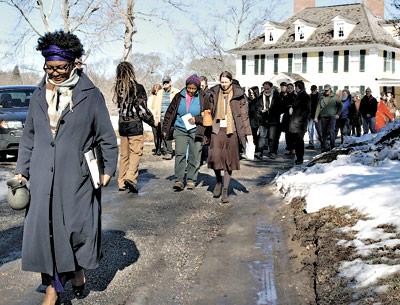Connections: Family Secrets

Almost by chance, but aware that it was Black History Month, my husband and I went to Shelter Island on Friday night for a program on the history of slavery sponsored by the Shelter Island Library and Sylvester Manor Educational Farm. We had been primed by Mac Griswold’s penetrating book, “The Manor: Three Centuries at a Slave Plantation on Long Island.”
The Shelter Island Library is small, and the event had not been widely publicized. Nevertheless, it drew an overflowing — and, I must add, multiracial — crowd. We had come to see “Traces of the Trade: A Story From the Deep North,” a film about the slave trade, and to hear a conversation about it.
The film is relevant to Sylvester Manor (which was farmed by slaves in the colonial era and beyond), but it also underscores something most of us don’t much think about: the complicity of Northerners in the perpetuation of slavery. We tend to forget that Abolitionists were a minority here in the North, and that the good citizens of New England and the Mid-Atlantic states not only dominated the American slave trade but also owned slaves well into the 19th century. Many fine old families made their fortunes on the backs of slaves.
The film is about the DeWolf family, illustrious and wealthy merchants of Bristol, R.I., who are said to have run the largest slave-trading company in United States history. Katrina Browne, a seventh-generation descendant, was born in Philadelphia, but her background in cultural anthropology and theology drew her to explore the personal as well as national consequences of America’s “peculiar institution.” She directed and wrote the film on a mission to find out, for herself and others, how so many otherwise decent people and respectable organizations either actively participated in the abominable institution of slavery, or looked the other way.
The film was eight years in the making. Along the way it took the filmmaker and nine other DeWolf descendants to Ghana in West Africa, where they visited dungeons in which those to be sold as chattel were imprisoned, and to Cuba, where the DeWolfs both sold slaves and held many captive on their five plantations at great profit.
The Triangular Trade, in which the Sylvester family of Sylvester Manor also took part, involved the cultivation of sugar for rum, which was used as currency (with other material goods) to buy Africans, and transport them in horrific conditions through the Middle Passage to the West. As is noted in the documentary, some 11 million people made the passage, a million dying along the way.
For Ms. Browne, who spoke after the screening, awareness was the first step toward uncovering hidden personal ideas about race and challenging herself and as many others as possible to open their eyes to our shared cultural legacy and begin a process of healing and reconciliation. “I was shocked . . . when I realized that instead of being the exception, the DeWolf family was just the tip of the iceberg of the vast complicity to slavery in New England,” she said in an interview.
Joining Ms. Browne in the conversation that followed the screening were her brother, Whitney Browne, Georgette Grief-Key, executive director of the Eastville Community Historical Society, Peggy King Forde, former director of the New York City African Burial Ground Project, and Sandra Arnold, who, under the auspices of Fordham University, is developing the National Burial Database Project of Enslaved African Americans. The audience was clearly moved.
First screened at the Sundance Film Festival, “Traces of the Trade” is available from the Tracing Center, an educational organization pursuing Ms. Browne’s mission.
There are lessons in this history for all of us. One of the DeWolf descendants makes a particularly insightful remark in the film, saying that he left for the trip to West Africa believing that his ancestors engaged in the slave trade centuries ago simply because that was the way things were done at the time — but that he returned home understanding that they “knew it was evil, but did it anyway.”
I think Ms. Browne’s idea of challenging ourselves to more frankly acknowledge our nation’s racist history is one all thoughtful people should embrace. And I wonder: Will our own descendants question our own complaisance? Will they wonder at our passive acceptance of today’s lingering, institutionalized racism, and the social injustice that still walks with it hand in hand?
